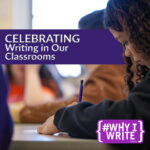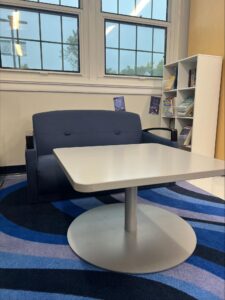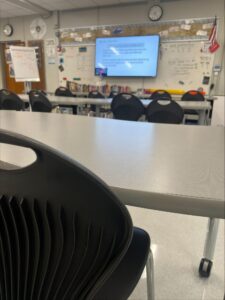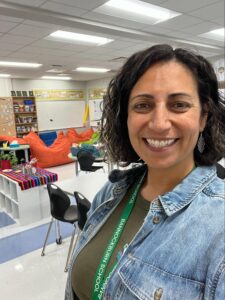 This blog post was written by NCTE member Jen Vincent as part of a blog series celebrating the National Day on Writing®. To draw attention to the remarkable variety of writing we engage in and to help make all writers aware of their craft, the National Council of Teachers of English has established October 20 as the National Day on Writing®. Resources, strategies, and inclusion in a blog post does not imply endorsement or promotion by NCTE.
This blog post was written by NCTE member Jen Vincent as part of a blog series celebrating the National Day on Writing®. To draw attention to the remarkable variety of writing we engage in and to help make all writers aware of their craft, the National Council of Teachers of English has established October 20 as the National Day on Writing®. Resources, strategies, and inclusion in a blog post does not imply endorsement or promotion by NCTE.
Recently, my aunt came to visit me at school because I’m coaching the girls’ volleyball team, and we had a home game. After the game, I walked her around the building and showed her my classroom.
She gasped when she walked into our learning space. To start, it’s one of the bigger rooms in the school but besides that, it’s welcoming. It’s colorful. We have different learning zones and choices for flexible seating. There’s student work around the room and shelves of books to explore. It was nice to see it from her perspective and to be reminded of how our space supports the work I do with my students.
colorful. We have different learning zones and choices for flexible seating. There’s student work around the room and shelves of books to explore. It was nice to see it from her perspective and to be reminded of how our space supports the work I do with my students.
As an English language arts teacher, I strive to grow a community of readers in my classroom as well as a community of writers. Explicitly making the connection between reading and writing helps students grow as both readers and writers, but, (not-so) secretly, writing is my true passion. I love writing with student writers! Co-creating a supportive classroom community that fosters conversations, commitment to growing as writers, and critical thinking is important to me. I’d like to think that when my aunt stepped into my classroom, even when the students weren’t there, she could feel our sense of community.
“Here’s where we start class,” I motioned to our more traditional seating where students can see our large format display. “I’ll display writing here and we’ll discuss it to see what moves the writer makes. And then we’ll try it in our own writing.”
Most days, we start class with a study of a mentor text. Students notice what choices the writer has made, talk about the impact of those choices, and then try the move or moves themselves. I smiled, remembering how last week a sixth grader wrote a few kind of creepy lines of dialogue after we studied a mentor text to look at how to use quotation marks and dialogue tags. We all wanted her to write the rest of the story!
“Look at all the windows!” my aunt marveled. “And there’s so many options for where to sit.”
 “The kids like to move around the room to work. They like the different choices for seating.” I glanced at a mini couch in the corner of the room where a small group of eighth graders tend to gather. During independent work time, I confer with students. Recently, I was meeting with one student about his writing and another overheard our whispered conversation. He chimed in as we talked about the deeper lesson they needed to work toward in their memoirs. I love when student writers can’t help but listen in and want to share their thinking too.
“The kids like to move around the room to work. They like the different choices for seating.” I glanced at a mini couch in the corner of the room where a small group of eighth graders tend to gather. During independent work time, I confer with students. Recently, I was meeting with one student about his writing and another overheard our whispered conversation. He chimed in as we talked about the deeper lesson they needed to work toward in their memoirs. I love when student writers can’t help but listen in and want to share their thinking too.
“And look at these! I bet the kids love these beanbags,” my aunt mused.
I walked over to the opposite corner of the room: our carpet meeting space. We have a bigger couch and beanbag-style pillow.
“Oh, they love these!” I told her.
At the beginning of our memoir unit, to study the structure of a memoir, we read an excerpt of Sy Montgomery’s memoir, How to Be a Good Creature. The seventh graders gathered at the carpet and followed along while I read to them about an octopus named Octavia. As I reached the end of the chapter, I fought back tears, my voice cracked, and the students listened in silence. Afterwards, we discussed how Montgomery moves back and forth between the present moment, flashbacks, internal thinking related to questions she was grappling with, and teaching the reader about the topic.
Later that afternoon, the eighth graders came into class eager to tell me that the seventh graders said I was bawling while reading to them. While I wasn’t, in fact, bawling, I did get emotional. Great writing should, after all, make us feel something. If I showed them that words can be powerful in that way, awesome! (I’m also not mad that they were talking about ELA during lunch/recess.)
“Golly. What lucky kids,” my aunt remarked. “And aren’t you lucky.”
I scanned the room one more time. Lucky, yes. But also grateful. Grateful for the time I get to spend there with the sixth-, seventh-, and eighth-grade readers and writers, for the space we have to connect with each other and the conversations we have about texts and our own writing, and for the memories I know I’ll carry with me—and hopefully they will too.
 Jen Vincent (she/her/ella) is a writer, educator, entrepreneur, and lover of life who celebrates the human experience through writing. She brings years of working in special education, writing curriculum, using instructional technology, coaching teachers, and working with multilingual learners to her work as a sixth–eighth grade middle school language arts teacher for Bannockburn School, a K–8 district in a northern suburb of Chicago. She is a National Board Certified Teacher in Early/Middle Childhood Literacy and an active member of NCTE. As the founder of Story Exploratory, she offers workshops, coaching, and professional development to help writers explore what it means to live the life of a writer. She’s currently writing her first book on student-centered, inquiry-based writing instruction which will be published next year with Stenhouse/Routledge. You can learn more about her at storyexploratory.com and visit her on Instagram at @jvincentwrites and @storyexploratory.
Jen Vincent (she/her/ella) is a writer, educator, entrepreneur, and lover of life who celebrates the human experience through writing. She brings years of working in special education, writing curriculum, using instructional technology, coaching teachers, and working with multilingual learners to her work as a sixth–eighth grade middle school language arts teacher for Bannockburn School, a K–8 district in a northern suburb of Chicago. She is a National Board Certified Teacher in Early/Middle Childhood Literacy and an active member of NCTE. As the founder of Story Exploratory, she offers workshops, coaching, and professional development to help writers explore what it means to live the life of a writer. She’s currently writing her first book on student-centered, inquiry-based writing instruction which will be published next year with Stenhouse/Routledge. You can learn more about her at storyexploratory.com and visit her on Instagram at @jvincentwrites and @storyexploratory.
It is the policy of NCTE in all publications, including the Literacy & NCTE blog, to provide a forum for the open discussion of ideas concerning the content and the teaching of English and the language arts. Publicity accorded to any particular point of view does not imply endorsement by the Executive Committee, the Board of Directors, the staff, or the membership at large, except in announcements of policy, where such endorsement is clearly specified.

